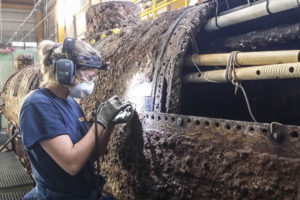(November 21, 2003 – CHARLESTON, SC) This week, Hunley staff scientists completed the excavation of the H. L. Hunley’s two ballast tanks. During excavation of this area, over 1.5 tons of sediment were removed and volunteers assisted in the screening and recording of the sediment. The excavation, which began in early October, yielded more 19th-century artifacts as well as valuable analytical data.
A wooden barrel was uncovered earlier in the excavation on the bottom port side of the forward ballast tank and appears to have been modified for use as a bucket. “It contained a relatively heavy and radio-dense substance that we believe may be a lead-based caulking material. Right next to the bucket lay an iron tool with the shape of a chisel that could be a caulking iron, used to caulk or repair leaks in the submarine,” said Maria Jacobsen, Senior Archaeologist for the Hunley project. A sample of the bucket’s contents has been sent to Clemson University for material analysis.
During the excavation of the aft ballast tank, scientists were slowed down due to the discovery of a coil of rope. The fragile, waterlogged rope was carefully removed for conservation and documentation.
Also during this time, archaeologists took the opportunity to revisit the central crew compartment and remove some of the heavier concreted artifacts from the area where Lt. Dixon, the Hunley’s commander, was stationed. The objects excavated were not easily recognizable and had to be x-rayed to be identified. Some of the objects recovered included a wrench, a hammer, and three bolts. An artillery button was also uncovered in the center of the crew compartment. “These tools raise questions as to whether Lt. Dixon was working on the submarine on the final night making repairs or adjustments. With the condensation in the submarine and the iron clad plates that are on the floor of the sub apparently to raise the crew’s feet above the water which would accumulate, it seems Dixon would not have carelessly kept these tools in the water on a regular basis where they would corrode. Thus, it would suggest he was possibly using the tools that night adding another clue to the operation of the submarine and the cause of it not returning home. The evidential jigsaw puzzle gets another piece of evidence as we put together the detailed story of the H. L. Hunley and its proud crew,” said Senator Glenn McConnell, Chairman of the Hunley Commission.
Scientists hope this phase of excavation will also provide valuable data that could help solve the mystery on why the Hunley never returned after becoming the first successful combat submarine in world history. The forward and aft ballast tanks both had damage to them and over time, the sediment that filled those areas formed layers, or strata. Studying how these strata formed could eventually provide clues to the mystery of why the Hunley vanished.
Warren Lasch, Chairman of Friends of the Hunley, said, “The Hunley’s disappearance will not remain an unsolved mystery. Through interdisciplinary scientific research and forensic analysis, we will ultimately be able to accurately tell the Hunley’s chapter in world history.”
In December, the Hunley project team will have the submarine mapped. Pacific Survey will use new 3D Digital equipment to scan the emptied ballast tanks and the fully excavated crew compartment.
The H. L. Hunley was located in 1995 by Clive Cussler’s National Underwater Agency (NUMA), a 501c3 non-profit organization. The hand-cranked submarine was raised in 2000 and delivered to the Warren Lasch Conservation Center, where an international team of scientists are at work excavating and conserving the historic vessel and its artifacts.
Hours of operation for public tours and the Hunley gift shop are from 10:00 a.m. to 5:00 p. m. on Saturdays and from noon to 5:00 p. m. on Sundays. All proceeds go to support the Hunley conservation and excavation project. To purchase tickets call toll free 1-877-4HUNLEY (1-877-448-6539) or log onto the Internet at www.etix.com.


